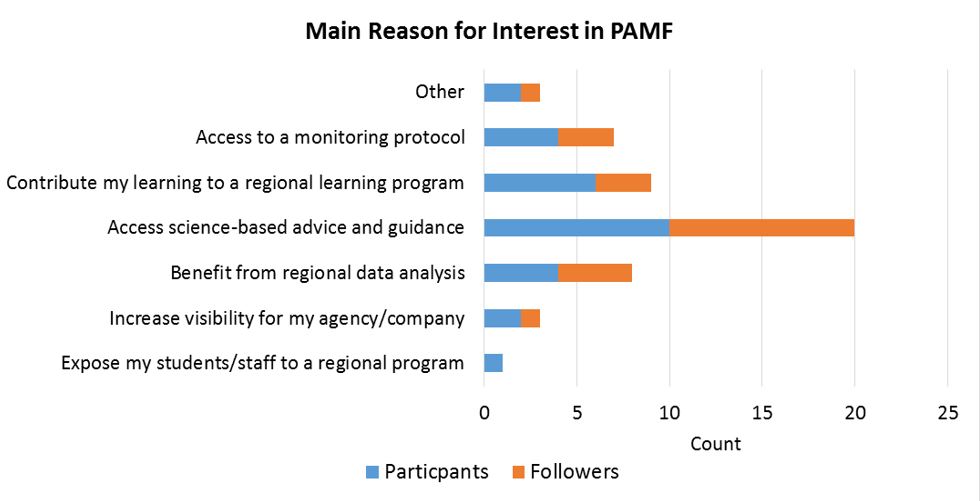February 21, 2018 | PAMF program staff
2017 PAMF Participant Survey Results
Phragmites is dormant right now, but the PAMF staff sure isn’t! PAMF is currently in its pilot year, and we have been very busy all winter, working to improve the program for its first full year of implementation in summer 2018. Last fall, we sent a survey to members of the PAMF Listserv and received feedback from 52 respondents. We asked about your experience with PAMF and how we can make that experience even better. We heard you! Now we would like to share some respondent insights that have been instrumental in further developing the PAMF program!
- The 52 responses came from 29 PAMF participants and 23 PAMF followers—both groups are very important to the program’s success!
- Nearly 60% of respondents had more than three years of experience managing Phragmites, and we look forward to learning from all you veterans. On the other hand, 25% had less than one year of Phragmites experience, and our goal is to provide you with science-backed treatment recommendations as you develop your management program.
- Both participants and followers expressed that the main reason for their interest in PAMF is access to science-based advice and guidance (Fig 1). This is indeed one of our primary purposes. By collecting data across the Great Lakes basin on treatment applications and changes in Phragmites infestation levels, PAMF participants are helping us better understand how site conditions and characteristics interact to influence treatment effectiveness. This collective learning will be communicated back to the Phragmites Phighting community to help reduce uncertainty in land managers’ control strategies.
- Among participants who took part in some aspect of PAMF in 2017, the services and resources that were deemed most important were the in-person trainings, participant guide, and participant kits. Given this feedback, we are beginning to schedule trainings for this upcoming June—keep an eye out for further communication. We have also made major revisions to the participant guide by adding more instructions, information, and examples. Additionally, we will be giving participant kits to new PAMFers.
- According to PAMF followers on our listserv, the main things that would increase their interest in PAMF were having more information on how to implement various treatments (70%), PAMF’s overall structure (52%), and how adaptive management can help (43%). In response, we have developed a document explaining the different treatment methods that will be published on our web hub. We are also revising the participant guide to clarify how PAMF works and the role that adaptive management plays. Followers also expressed a desire to know who else is participating (48%)—we are exploring ways to share this information (with proper permissions, of course!).
- The average 2017 participant felt they were moderately important to PAMF. We want to communicate very clearly that each and every one of you is critical to PAMF’s success. Without your input, control efforts, data collection, and patience, PAMF could not happen.
- Eighty-three percent of participants said they are interested in continuing to participate in PAMF in 2018, while 0% said they are no longer interested in continuing. Thirty-one percent said they will likely enroll more sites.
We are grateful to those who completed the survey. A lot of the improvements we have been making are a direct result of your responses. With your cooperation and feedback, PAMF is set up to successfully implement adaptive management in Phragmites control efforts for this upcoming season and for many more seasons to come.
If you are interested in joining PAMF, please visit the Join PAMF page, or email us for more information.

Fig 1: The main reasons participants and followers are interested in PAMF.
